Claudia Plant
University of Vienna, Austria
Bootstrap Deep Spectral Clustering with Optimal Transport
Aug 06, 2025Abstract:Spectral clustering is a leading clustering method. Two of its major shortcomings are the disjoint optimization process and the limited representation capacity. To address these issues, we propose a deep spectral clustering model (named BootSC), which jointly learns all stages of spectral clustering -- affinity matrix construction, spectral embedding, and $k$-means clustering -- using a single network in an end-to-end manner. BootSC leverages effective and efficient optimal-transport-derived supervision to bootstrap the affinity matrix and the cluster assignment matrix. Moreover, a semantically-consistent orthogonal re-parameterization technique is introduced to orthogonalize spectral embeddings, significantly enhancing the discrimination capability. Experimental results indicate that BootSC achieves state-of-the-art clustering performance. For example, it accomplishes a notable 16\% NMI improvement over the runner-up method on the challenging ImageNet-Dogs dataset. Our code is available at https://github.com/spdj2271/BootSC.
MultiADS: Defect-aware Supervision for Multi-type Anomaly Detection and Segmentation in Zero-Shot Learning
Apr 09, 2025Abstract:Precise optical inspection in industrial applications is crucial for minimizing scrap rates and reducing the associated costs. Besides merely detecting if a product is anomalous or not, it is crucial to know the distinct type of defect, such as a bent, cut, or scratch. The ability to recognize the "exact" defect type enables automated treatments of the anomalies in modern production lines. Current methods are limited to solely detecting whether a product is defective or not without providing any insights on the defect type, nevertheless detecting and identifying multiple defects. We propose MultiADS, a zero-shot learning approach, able to perform Multi-type Anomaly Detection and Segmentation. The architecture of MultiADS comprises CLIP and extra linear layers to align the visual- and textual representation in a joint feature space. To the best of our knowledge, our proposal, is the first approach to perform a multi-type anomaly segmentation task in zero-shot learning. Contrary to the other baselines, our approach i) generates specific anomaly masks for each distinct defect type, ii) learns to distinguish defect types, and iii) simultaneously identifies multiple defect types present in an anomalous product. Additionally, our approach outperforms zero/few-shot learning SoTA methods on image-level and pixel-level anomaly detection and segmentation tasks on five commonly used datasets: MVTec-AD, Visa, MPDD, MAD and Real-IAD.
An Introductory Survey to Autoencoder-based Deep Clustering -- Sandboxes for Combining Clustering with Deep Learning
Apr 02, 2025Abstract:Autoencoders offer a general way of learning low-dimensional, non-linear representations from data without labels. This is achieved without making any particular assumptions about the data type or other domain knowledge. The generality and domain agnosticism in combination with their simplicity make autoencoders a perfect sandbox for researching and developing novel (deep) clustering algorithms. Clustering methods group data based on similarity, a task that benefits from the lower-dimensional representation learned by an autoencoder, mitigating the curse of dimensionality. Specifically, the combination of deep learning with clustering, called Deep Clustering, enables to learn a representation tailored to specific clustering tasks, leading to high-quality results. This survey provides an introduction to fundamental autoencoder-based deep clustering algorithms that serve as building blocks for many modern approaches.
I Want 'Em All (At Once) -- Ultrametric Cluster Hierarchies
Feb 19, 2025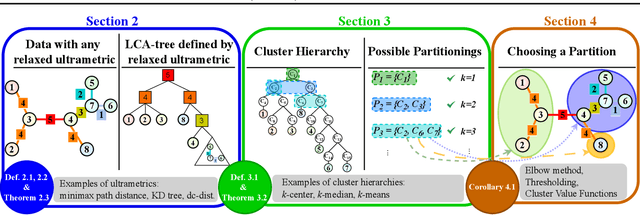
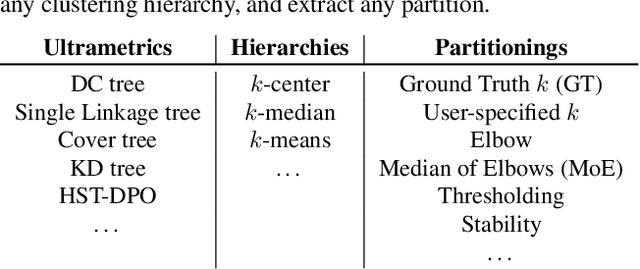
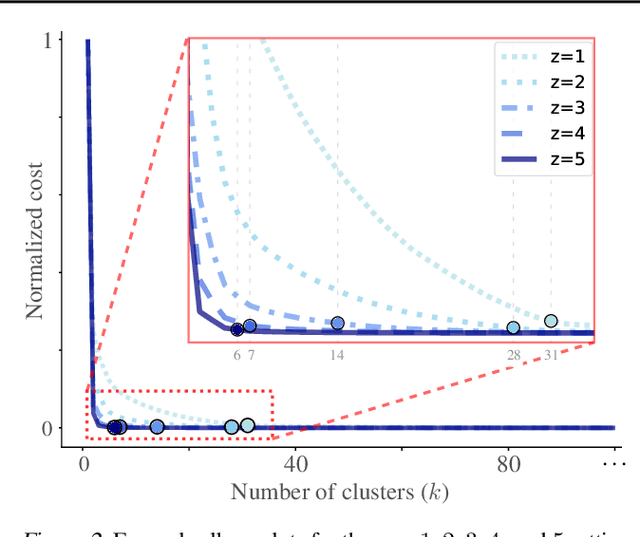
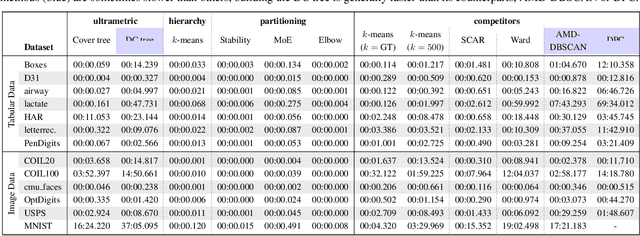
Abstract:Hierarchical clustering is a powerful tool for exploratory data analysis, organizing data into a tree of clusterings from which a partition can be chosen. This paper generalizes these ideas by proving that, for any reasonable hierarchy, one can optimally solve any center-based clustering objective over it (such as $k$-means). Moreover, these solutions can be found exceedingly quickly and are themselves necessarily hierarchical. Thus, given a cluster tree, we show that one can quickly access a plethora of new, equally meaningful hierarchies. Just as in standard hierarchical clustering, one can then choose any desired partition from these new hierarchies. We conclude by verifying the utility of our proposed techniques across datasets, hierarchies, and partitioning schemes.
Motif Discovery Framework for Psychiatric EEG Data Classification
Jan 08, 2025Abstract:In current medical practice, patients undergoing depression treatment must wait four to six weeks before a clinician can assess medication response due to the delayed noticeable effects of antidepressants. Identification of a treatment response at any earlier stage is of great importance, since it can reduce the emotional and economic burden connected with the treatment. We approach the prediction of a patient response to a treatment as a classification problem, by utilizing the dynamic properties of EEG recordings on the 7th day of the treatment. We present a novel framework that applies motif discovery to extract meaningful features from EEG data distinguishing between depression treatment responders and non-responders. We applied our framework also to classification tasks in other psychiatric EEG datasets, namely to patients with symptoms of schizophrenia, pediatric patients with intractable seizures, and Alzheimer disease and dementia. We achieved high classification precision in all data sets. The results demonstrate that the dynamic properties of the EEGs may support clinicians in decision making both in diagnosis and in the prediction depression treatment response as early as on the 7th day of the treatment. To our best knowledge, our work is the first one using motifs in the depression diagnostics in general.
Plasticity Loss in Deep Reinforcement Learning: A Survey
Nov 07, 2024
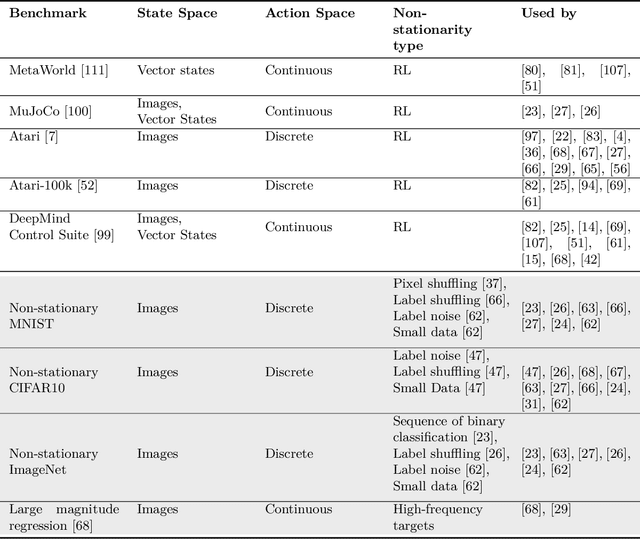
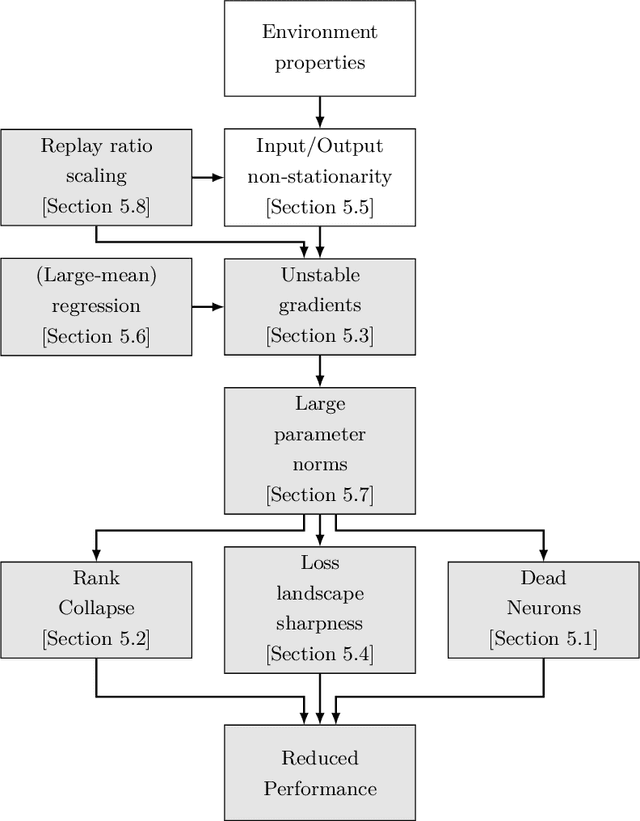
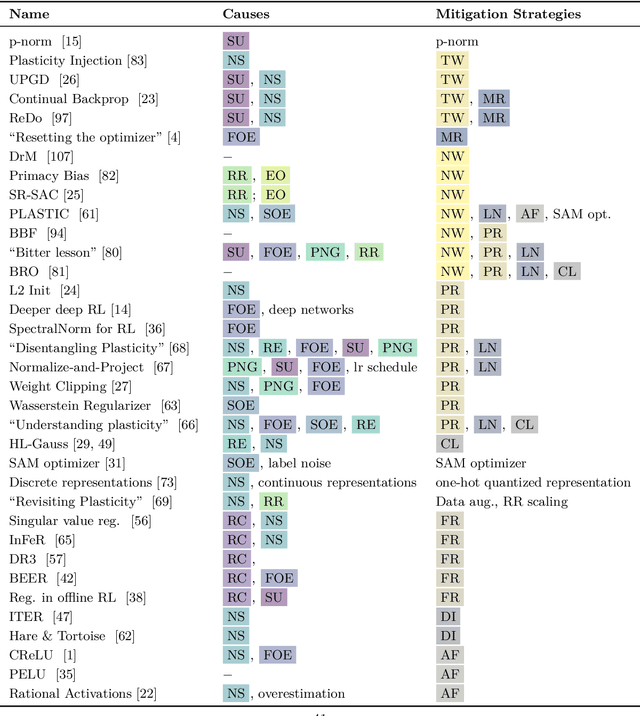
Abstract:Akin to neuroplasticity in human brains, the plasticity of deep neural networks enables their quick adaption to new data. This makes plasticity particularly crucial for deep Reinforcement Learning (RL) agents: Once plasticity is lost, an agent's performance will inevitably plateau because it cannot improve its policy to account for changes in the data distribution, which are a necessary consequence of its learning process. Thus, developing well-performing and sample-efficient agents hinges on their ability to remain plastic during training. Furthermore, the loss of plasticity can be connected to many other issues plaguing deep RL, such as training instabilities, scaling failures, overestimation bias, and insufficient exploration. With this survey, we aim to provide an overview of the emerging research on plasticity loss for academics and practitioners of deep reinforcement learning. First, we propose a unified definition of plasticity loss based on recent works, relate it to definitions from the literature, and discuss metrics for measuring plasticity loss. Then, we categorize and discuss numerous possible causes of plasticity loss before reviewing currently employed mitigation strategies. Our taxonomy is the first systematic overview of the current state of the field. Lastly, we discuss prevalent issues within the literature, such as a necessity for broader evaluation, and provide recommendations for future research, like gaining a better understanding of an agent's neural activity and behavior.
Breaking the Reclustering Barrier in Centroid-based Deep Clustering
Nov 04, 2024



Abstract:This work investigates an important phenomenon in centroid-based deep clustering (DC) algorithms: Performance quickly saturates after a period of rapid early gains. Practitioners commonly address early saturation with periodic reclustering, which we demonstrate to be insufficient to address performance plateaus. We call this phenomenon the "reclustering barrier" and empirically show when the reclustering barrier occurs, what its underlying mechanisms are, and how it is possible to Break the Reclustering Barrier with our algorithm BRB. BRB avoids early over-commitment to initial clusterings and enables continuous adaptation to reinitialized clustering targets while remaining conceptually simple. Applying our algorithm to widely-used centroid-based DC algorithms, we show that (1) BRB consistently improves performance across a wide range of clustering benchmarks, (2) BRB enables training from scratch, and (3) BRB performs competitively against state-of-the-art DC algorithms when combined with a contrastive loss. We release our code and pre-trained models at https://github.com/Probabilistic-and-Interactive-ML/breaking-the-reclustering-barrier .
SHADE: Deep Density-based Clustering
Oct 08, 2024



Abstract:Detecting arbitrarily shaped clusters in high-dimensional noisy data is challenging for current clustering methods. We introduce SHADE (Structure-preserving High-dimensional Analysis with Density-based Exploration), the first deep clustering algorithm that incorporates density-connectivity into its loss function. Similar to existing deep clustering algorithms, SHADE supports high-dimensional and large data sets with the expressive power of a deep autoencoder. In contrast to most existing deep clustering methods that rely on a centroid-based clustering objective, SHADE incorporates a novel loss function that captures density-connectivity. SHADE thereby learns a representation that enhances the separation of density-connected clusters. SHADE detects a stable clustering and noise points fully automatically without any user input. It outperforms existing methods in clustering quality, especially on data that contain non-Gaussian clusters, such as video data. Moreover, the embedded space of SHADE is suitable for visualization and interpretation of the clustering results as the individual shapes of the clusters are preserved.
Temporal Subspace Clustering for Molecular Dynamics Data
Jul 31, 2024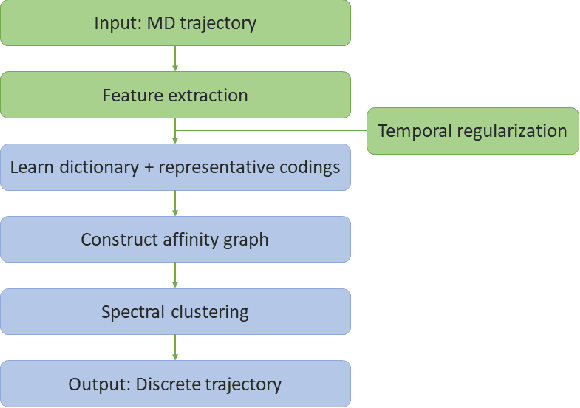

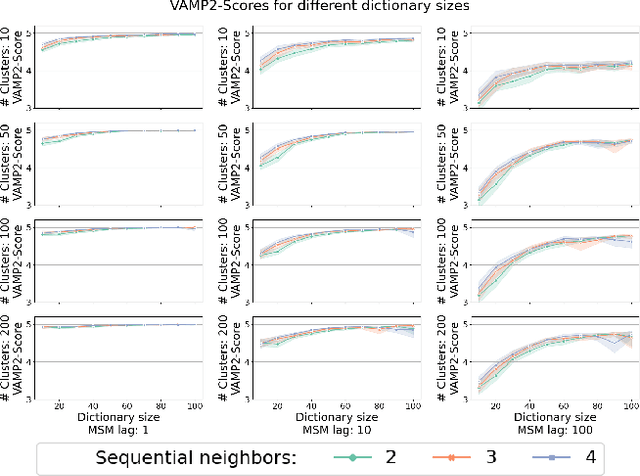
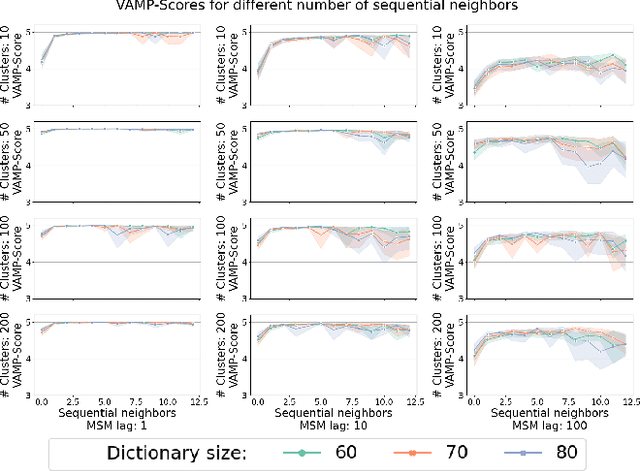
Abstract:We introduce MOSCITO (MOlecular Dynamics Subspace Clustering with Temporal Observance), a subspace clustering for molecular dynamics data. MOSCITO groups those timesteps of a molecular dynamics trajectory together into clusters in which the molecule has similar conformations. In contrast to state-of-the-art methods, MOSCITO takes advantage of sequential relationships found in time series data. Unlike existing work, MOSCITO does not need a two-step procedure with tedious post-processing, but directly models essential properties of the data. Interpreting clusters as Markov states allows us to evaluate the clustering performance based on the resulting Markov state models. In experiments on 60 trajectories and 4 different proteins, we show that the performance of MOSCITO achieves state-of-the-art performance in a novel single-step method. Moreover, by modeling temporal aspects, MOSCITO obtains better segmentation of trajectories, especially for small numbers of clusters.
Advancing Anomaly Detection: Non-Semantic Financial Data Encoding with LLMs
Jun 05, 2024

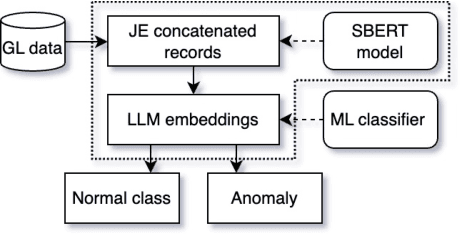

Abstract:Detecting anomalies in general ledger data is of utmost importance to ensure trustworthiness of financial records. Financial audits increasingly rely on machine learning (ML) algorithms to identify irregular or potentially fraudulent journal entries, each characterized by a varying number of transactions. In machine learning, heterogeneity in feature dimensions adds significant complexity to data analysis. In this paper, we introduce a novel approach to anomaly detection in financial data using Large Language Models (LLMs) embeddings. To encode non-semantic categorical data from real-world financial records, we tested 3 pre-trained general purpose sentence-transformer models. For the downstream classification task, we implemented and evaluated 5 optimized ML models including Logistic Regression, Random Forest, Gradient Boosting Machines, Support Vector Machines, and Neural Networks. Our experiments demonstrate that LLMs contribute valuable information to anomaly detection as our models outperform the baselines, in selected settings even by a large margin. The findings further underscore the effectiveness of LLMs in enhancing anomaly detection in financial journal entries, particularly by tackling feature sparsity. We discuss a promising perspective on using LLM embeddings for non-semantic data in the financial context and beyond.
 Add to Chrome
Add to Chrome Add to Firefox
Add to Firefox Add to Edge
Add to Edge